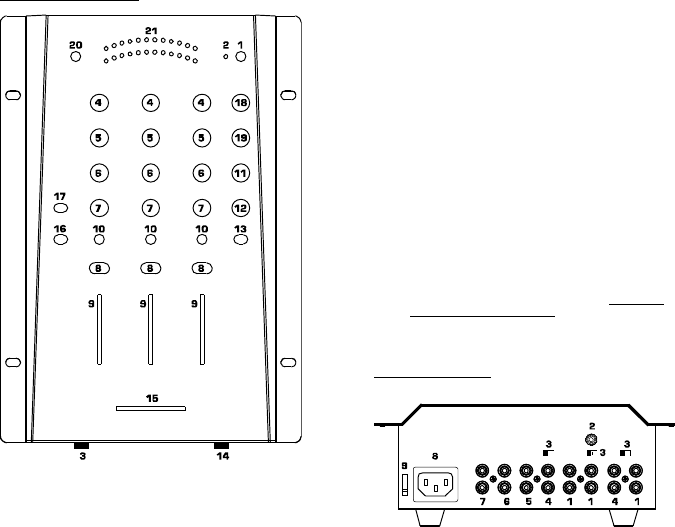
FRONT PANEL FEATURES
1. Power Switch: Use this switch to turn on the
mixer after all input devices are already connected
to prevent damage to your equipment. Turn the
mixer on before you turn on amplifiers and turn of
amplifiers before you turn off the mixer.
2. Power LED: Illuminates when the mixer is on.
3. Microphone Input Jack: Connect your DJ mic at
this location.
4. Channel Gain: This rotary control adjusts the pre-
fader input level.
5. Channel Treble: This rotary control adjusts the
high-tone level.
6. Channel Middle: This rotary control adjusts the
middle-tone level.
7. Channel Bass: This rotary control adjusts the low-
tone level.
8. Input Selector: This toggles select what input
source is routed to the channel from the rear panel
connected units.
9. Channel Fader: This slide fader is used to adjust
the level sent to program mix.
10. Cue Button: pressing this button sends post gain,
post EQ, and pre channel fader level audio the PFL
“Pre–fader level” section of the headphone cue.
11. Headphone Volume: This rotary control adjusts
the volume level of the headphone output.
12. Headphone Mix: Program level and PFL (CUE)
signal levels can be mixed by this slider. When all
the way left, audio heard will be determined by Cue
Button selections. When all the way right final only
(PGM) program mix audio will be heard.
13. Split/Blend Button: When in the down position,
headphone audio will be split so mono PFL audio is
in the left ear and mono PGM audio is in the right
ear. When the button is up, stereo PFL and PGM
audio will be mixed (blended).
14. Headphone Jack: Your headphones can be
connected to this ¼” terminal. The volume should
always be set at its lowest setting while connecting
and disconnecting headphones to prevent damage
to headphones and/or your hearing.
15. Replaceable Crossfader: This slide fader blends
audio between the channels assigned to the left and
right assign switches.
Note: This fader is user replaceable if it should ever
wear out. Simply remove the facepanel and then
remove the screws holding it in position. Replace
the fader with a quality authorized replacement
from your local Numark retailer.
16. Crossfader Direction: Activation of this switch
reverses the assignment of CH-1 and CH-2 on the
crossfader.
17. Crossfader Contour Control: The position of this
control determines how quickly or intensely the
crossfader will blend.
18. Master: This control adjusts the main output
volume using the PROGRAM audio as a source.
19. Booth/Zone Fader: controls volume for a remote
zone or booth monitors using PROGRAM audio as a
source.
Note: This could also be used to supply line level
audio to a lighting controller or to lights that are
sound activated.
20. Meter Assign: determines whether PFL or post
master level audio is sent to the stereo LED meter.
21. Stereo Level Indicator: quickly and accurately
tracks level of audio sent to it. When using as a
master output meter, set the crossover, equalizer
and power amp inputs to avoid distortion at each
step in the audio chain. Proper attention to the peak
meter results in the punchiest possible sound
without audible distortion. When used to adjust
the PFL levels, PFL cue signal is sent to the meter
through the cue assign buttons. Accurately match
channel levels with the Pre-fader gain and EQ
controls before mixing them together. The idea is
to properly match PFL inputs, not the input with the
stereo output meter!
REAR CONNECTIONS
1. Phono Inputs: This input is used for connecting your
turntables through the sensitive RIAA phono
preamplifiers. Only turntables with phono level
output should be attached. Line level turntables
must be attached to the line inputs.
2. GND: This screw connector should be used to secure
any turntables or other devices connected to the
mixer that need to be grounded.
3. Phono/Line Source Switch: This switch activates
and deactivates the sensitive RIAA phono
preamplifiers. Only turntables with phono level
output should be assigned when the switch is in
the phono position. Some turntables offer line
level output. To use these turntables and other line
devices like CD players, switch the input to Line.
4. Line Inputs: CD players, Tape Decks, Samplers or
other line level input devices should be connected to
these inputs.
5. Record Output: This RCA output is for connecting a
recording device such as a tape deck or CD recorder.
The level of the record output is based upon pre-
master levels.
6. Zone Output (RCA): This output is for connecting an
external monitoring device such as a PA system,
powered monitors or a home stereo. The level of the
zone stereo output signal is controlled by the zone
fader.
7. Master Output (RCA): This output is for connecting
an external monitoring device such as a PA system,
powered monitors or a home stereo. The level of the
master stereo output signal is controlled by the
master fader.
8. AC In: This mixer is designed to work with the power
supply cord that comes with the unit. While the power
is switched off, plug the power supply into the mixer
first, then plug it into the outlet.
9. Voltage Selector: Set this to the correct voltage for
your location standard.















